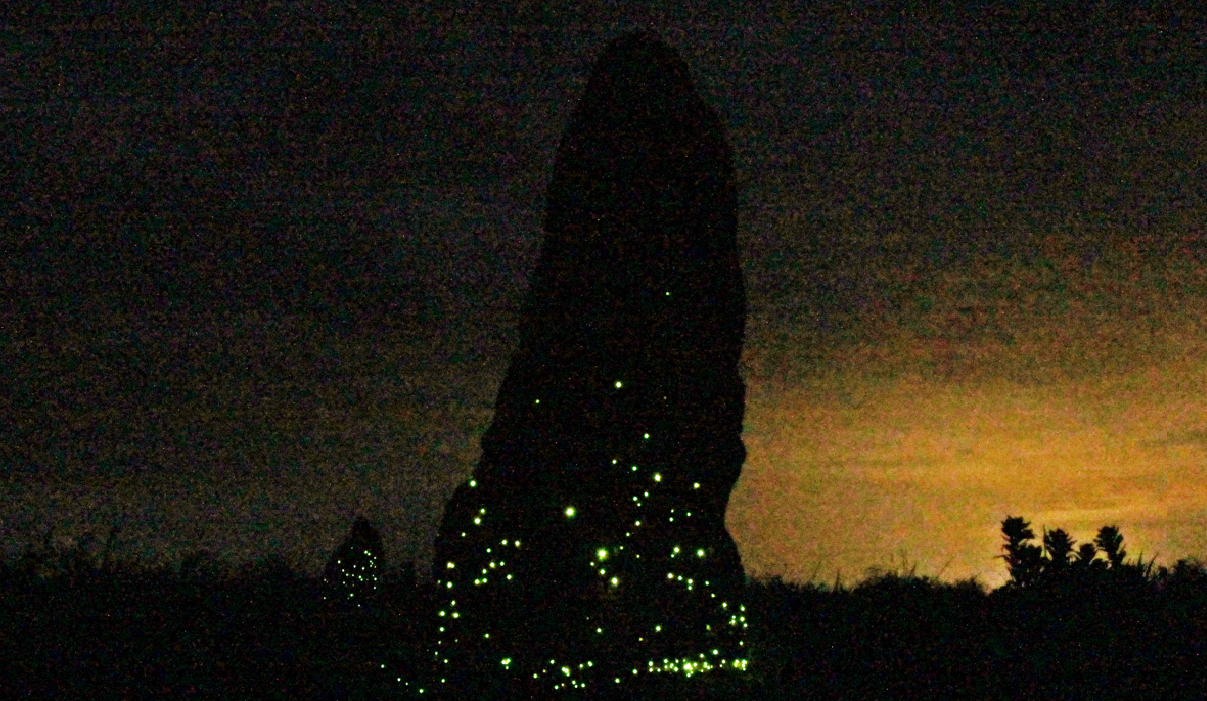


Luminous termite mound in Emas National Park, Goiás state: larvae of click beetle Pyrearinus termitilluminans produce a spectacle now confined to the park, an island in an ocean of monoculture (photo: Vadim Viviani)
Published on 01/02/2024
By André Julião | Agência FAPESP – At night in the Cerrado, Brazil’s savanna and second-largest biome, larvae of the click beetle Pyrearinus termitilluminans, which live in termite mounds, display green lanterns to capture prey attracted by the bright light.
In more than 30 years of expeditions with his students to Emas National Park and farms around the conservation unit in Goiás state to collect specimens, the phenomenon has never been so rare, said Vadim Viviani, a professor at the Federal University of São Carlos’s Science and Technology for Sustainability Center (CCTS-UFSCar) in Sorocaba, São Paulo state.
“In the 1990s, we would see many of these termite mounds full of fireflies and other bioluminescent insects, even in areas of pasture. Now, sugarcane is grown in most of the areas and we hardly see any,” he noted.
The dearth was one of the main findings of a study supported by FAPESP via its Research Program on Biodiversity Characterization, Conservation, Restoration and Sustainable Use (BIOTA-FAPESP), as reported in an article by Viviani and collaborators published in Annals of the Entomological Society of America.
The penultimate author of the article, Etelvino Bechara, a professor at the University of São Paulo’s Institute of Chemistry (IQ-USP), was Viviani’s master’s and PhD thesis advisor in the 1990s and is also supported by FAPESP.
The other co-authors are Cleide Costa, a researcher at the University of São Paulo’s Museum of Zoology (MZ-USP), and Simone P. Rosa, an entomologist at the Federal University of Itajubá (UNIFEI) in Minas Gerais state. Both are authorities on the taxonomy of the click beetle superfamily Elateroidea.
The survey recorded 51 species, most of which are fireflies (Lampyridae). The rest are click beetles (Elateridae), which have two lanterns on their back, and railroad worms, also known as glow worms (Phengodidae), which can produce light of different colors at the same time.
In Goiás, besides the specimens collected in Emas National Park in the municipality of Mineiros, and nearby farms, the researchers cataloged specimens in Perolândia and Campinorte. In Mato Grosso state, the survey covered Chapada dos Guimarães National Park and three towns (Alto Garças, Novo Santo Antônio and Rio Manso). In Costa Rica, a town in Mato Grosso do Sul state, they visited two farms and Sucuriú Falls Municipal Park. Emas National Park was the most productive site, providing 35 species.
The researchers say the diversity of these beetles in remnants of the Cerrado and farms neighboring the park has declined sharply over the last three decades, concurrently with the substitution of soybean and sugarcane plantations for pasture, as well as a reduction in the Cerrado overall, and more specifically in dense dry forest areas within the Cerrado known as cerradão.
The occurrence of luminous termite mounds in Chapada dos Guimarães National Park is reported for the first time in this article. Many mounds full of firefly larvae are found in Emas National Park and neighboring areas. Previous research by the same group reported the phenomenon of bioluminescence in the Amazon Rainforest (read more at: agencia.fapesp.br/23640).
Railroad worms are disappearing
Pesticides and artificial lighting are also enemies of bioluminescent beetles. Bright light produced by humans prevents them from being located by mates and reproducing. In particular, the researchers noted the absence of railroad worm larvae in recent expeditions. These insects can emit red and green light at the same time and have significant biotechnological potential (read more at: agencia.fapesp.br/31481).
“The decline in this family [Phengodidae] was especially evident. Adult males are no longer attracted to light traps on farms surrounded by sugarcane since 2010. Furthermore, the increasing levels of artificial light coming from nearby urban centers at night may threaten several bioluminescent species inside Emas National Park. The problem merits special attention and further studies,” Viviani said.
Extinction of bioluminescent species is not only a loss to biodiversity and the ecosystem services provided by these animals but also represents lost technological and economic opportunities.
Bioluminescence – production and emission of cold visible light by living beings – is useful to many analytical processes deployed in scientific research, medicine, industry and environmental management. Cold light means less than 20% of the light generates thermal radiation (i.e. heat).
Bioluminescence derives from oxidation of luciferin, a compound present in these insects and other animals as well as some fungi. The oxidation process is catalyzed by enzymes known as luciferases.
Over the years, the group led by Viviani has isolated and cloned the largest number of luciferases of any group globally. The luciferases are from different insects, including flies that produce blue light (read more at: agencia.fapesp.br/34061 and agencia.fapesp.br/29066).
Luminescent beetles produce colors such as green, yellow, orange and red. Their luciferases are used to mark cells and proteins, for example (read more at: agencia.fapesp.br/36427 and agencia.fapesp.br/20609).
Viviani is currently coordinating a project supported by FAPESP to develop bioluminescent reagents for immunoassays, environmental analysis and bioimaging. The reagents will be based on luciferases from Brazilian species. Most of these materials are currently imported.
“It’s important to grasp the fact that the Cerrado isn’t just scrub or bush. It’s a repository of water in the soil, a source of evaporation that generates rain, and also an immense store of exclusive species. We can learn a tremendous amount from all that treasure,” Viviani said.
The article “Inventory and ecological aspects of bioluminescent beetles in the Cerrado ecosystem and its decline around Emas National Park (Brazil)” is at: academic.oup.com/aesa/advance-article/doi/10.1093/aesa/saad029/7289072.
Source: https://agencia.fapesp.br/50536